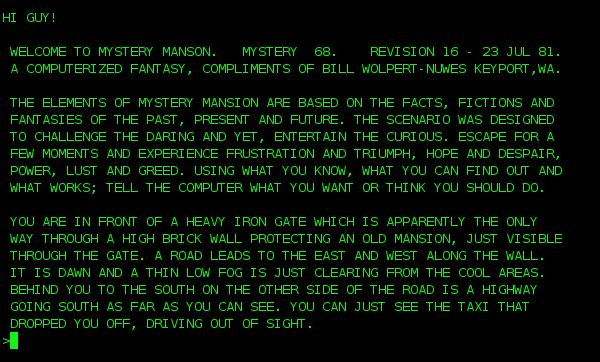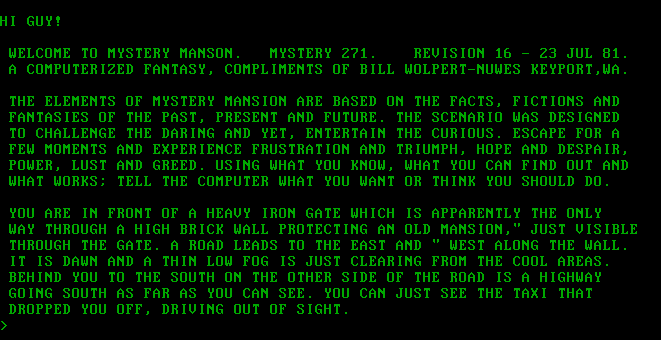
This is a conversion of the HP1000 RTE-IVB version of Mystery
Mansion to a PC platform. The Dos port is an almost exact duplicate of
the HP program, the F2C utility was used to convert the FORTRAN source
into C modules with another C module for interpreting RTE OS calls.
When I got the files I modified the source to be compatible with a
modern f2c utility running under Ubuntu Linux, and fixed a few spurious
punctuation issues relating to the 72-character code limitation of the
original HP1000 compiler.
The opening screen of the Linux version...

...and this is from the Dos version...

The green-on-black colors are not part of the program, in the Linux
version that's how I have my default "Konsole" terminal set, and in the
case of the Dos version the batch I used to run it contains an echo
line that sends <esc>[32;40m to set the ANSI screen colors. XP's
"dos" console doesn't do ANSI but permits setting screen colors
directly for a specific program. Either way something needs to be done
to make the window stay open after the program exits to preserve the
final text.
The origins of this game are somewhat a mystery... that fits. The Mystery Mansion
Wikipedia article mentions there was a HP1000 and a HP3000 version,
another article says the HP1000 version was first. In the HP1000 source
columns 73-80 contain sequence numbers, apparently added to the
original source as it overwrote the ends of some of the comments and
code in column 73, which apparently originally contained commas
separating text fields in about 20 places. Back in those days editing
was expensive, often it had to be done by specifying each correction in
coded form on a separate papertape or file to control how the "symbolic
editor" would process the file to be edited to create a corrected
file... yikes! no wonder old-comp games often contain minor text
glitches. But these days its a simple matter to type "MMM into a text
editor's search function and find every place where the code possibly
got
overwritten. Good thing those sequence strings were added, they made it
possible to quickly make "fixes" without having to hunt through a very
large source file (or have to read much of the text). No changes were
made to
the program logic, I only "fixed" things that were obviously artifacts
of the compile process and in one case corrected what appeared to be an
inadvertent line feed and moved the words around accordingly. The rest
was simply getting it to compile using Linux tools.
Last mod 1/18/08